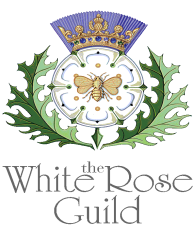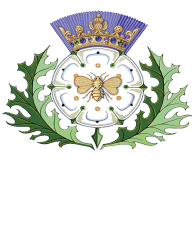The Unicorn, National Animal of Scotland.
by Jessica Brain
When one thinks about Scotland and all the cultural symbols, legends and rich heritage of the country, what comes to mind? Maybe the thistle, the famous tartan, the iconic bagpipes, or even the Loch Ness monster.
Whilst this is all correct, one mystical figure has been hiding in plain sight across the nation, a mythological creature which has been tied to Scotland as a national symbol for centuries – the unicorn.
The unicorn was and still is an important creature with great symbolism of purity and innocence, power and ferocity. Throughout the ages, records of unicorns have entered the story-telling fables of several cultures. Historic accounts even include some sightings of creatures with one horn, said to resemble such an animal.
Across ancient civilisations ranging from the Persians, the Egyptians, Indians and Greeks, such a creature was described and recorded, often with magical connotations. Even the Bible makes a record of an animal called the re’em which has been later associated with the unicorn.
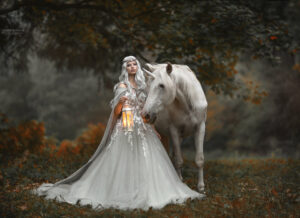
Whilst the animal did not appear in the vast volumes of Greek mythological tales, it was cited by philosophers and writers who believed in the reality of such a creature, with figures such as the famous Greek geographer Strabo claiming such creatures lived in the Caucasus region, whilst other philosophers were convinced of their existence in India. Whatever the location, the sighting of such an animal was a rare and mystical event. Often associated with the moon and believed to have great healing powers, the unicorn quickly acquired different meanings in different cultures.
In the coming centuries, the medieval depiction of a unicorn became a much beloved symbol in Christian art and even today, the unicorn holds resonance as a fantastical delightful creature which has captured the imagination of generations of people.
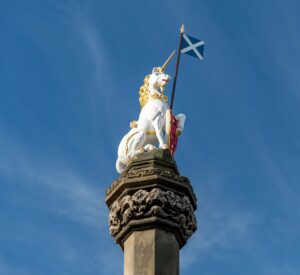
Scotland’s deep connections with the unicorn stem from its Celtic culture. Celtic mythology believed unicorns to represent innocence and purity whilst also being associated with chivalry, pride and boldness.
The first recorded use of a unicorn symbol is in the twelfth century when it was adopted by William I on the Scottish Royal Coat of Arms.
By the fifteenth century, during the reign of King James III, coins depicting the unicorn had also appeared and would be in circulation for another century.
Furthermore, the Mercat Cross, erected across Scottish towns, cities and even villages, also incorporated the symbol of the unicorn, with some carving the mystical creature on the pillars. The Mercat Cross was a significant landmark for each location, serving at the nucleus of the community where ceremonies took place. The unicorn therefore represented the nation at the heart of these settlements. One such example to be found today includes the unicorn finial on the cross at the small fishing town at Prestonpans, east of Edinburgh.
Moreover, at this time some significant members of the nobility were given permission to use the unicorn in their Coat of Arms. Such special permission was granted to the Earl of Kinnoull and was seen as an honour to bear such a symbol.
This emblem thus became ubiquitous and would remain so even when the momentous union of the crowns occurred in 1603. King James VI of Scotland became King of England and Ireland on the 24th March and reigned until his death in 1625.
When he inherited the English and Irish thrones, the Royal Arms of England became merged with that of Scotland and the Royal Coat of Arms of Ireland was also added. Thus, the symbol of the majestic English lion was incorporated side by side with the Scottish unicorn.
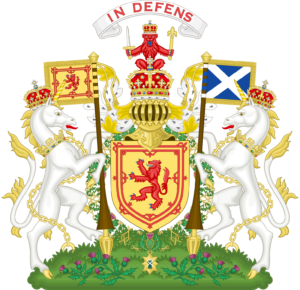
Still today, different versions of the Royal Arms exist, with the Scottish version maintaining stronger Scottish symbolism with thistles and the unicorn remaining on the left side.
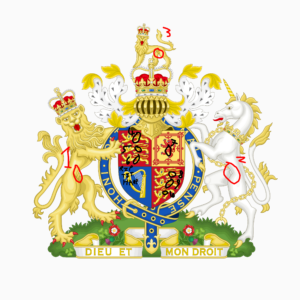
One particularly significant aspect in the heraldry of the unicorn is the gold chain which is used to restrain the unicorn. The chain wraps around the animal, perhaps depicting the enormous power of the mystical beast which is often described as untameable and powerful, or perhaps showing the control of the Scottish kings over such a bold creature.
The use of the unicorn alongside the lion is also very symbolic, not just in its representation of two nations brought together by a union of crowns but also as two animals which have legendary status as natural enemies, as recorded in the traditional nursery rhyme.
The lion and the unicorn
Were fighting for the crown
The lion beat the unicorn
All around the town.
Some gave them white bread,
And some gave them brown;
Some gave them plum cake
and drummed them out of town.
And when he had beat him out,
He beat him in again;
He beat him three times over,
His power to maintain.
This rhyme uses the lion and unicorn as the two protagonists and served as inspiration for others in the literary realm, including the famous writer Lewis Carroll who used the characters in “Through the Looking-Glass”. The unicorn and lion as symbols thus pervaded different forms of cultural expression, being used in art, literature and as representations of nations, cultures and history.
One such example of the cultural significance of the unicorn is demonstrated in the “The Hunt of the Unicorn” legend, less formally known as the Unicorn Tapestries which are housed and displayed both at the New York Metropolitan Museum of Art and Stirling Castle.
Whilst the origins of the work are French, the tapestry depicts the unicorn chained, similarly to its representation on the Royal Coat of Arms. The historical artefact is steeped in religious symbolism and demonstrates just how vital the mystical creature was in several cultures, being used to represent something “higher”, perhaps even unattainable.
Today in Scotland, the unicorn has left an imprint on the country, whether it is found at the gatepost of Holyroodhouse or standing proudly in front of St Margaret’s Chapel at Edinburgh Castle. The unicorn is depicted across the country, carved in stone at St Andrews University and used as a figurehead for the HM Frigate Unicorn in Dundee.
The unicorn heraldry is emblematic of the Scottish heritage and a valuable artefact denoting the ancient beliefs and value of this magical creature.
© Photos: Marketa Novak, model: Bára Marková crown: A Mon Seul Desire. Text by Jessica Brain
